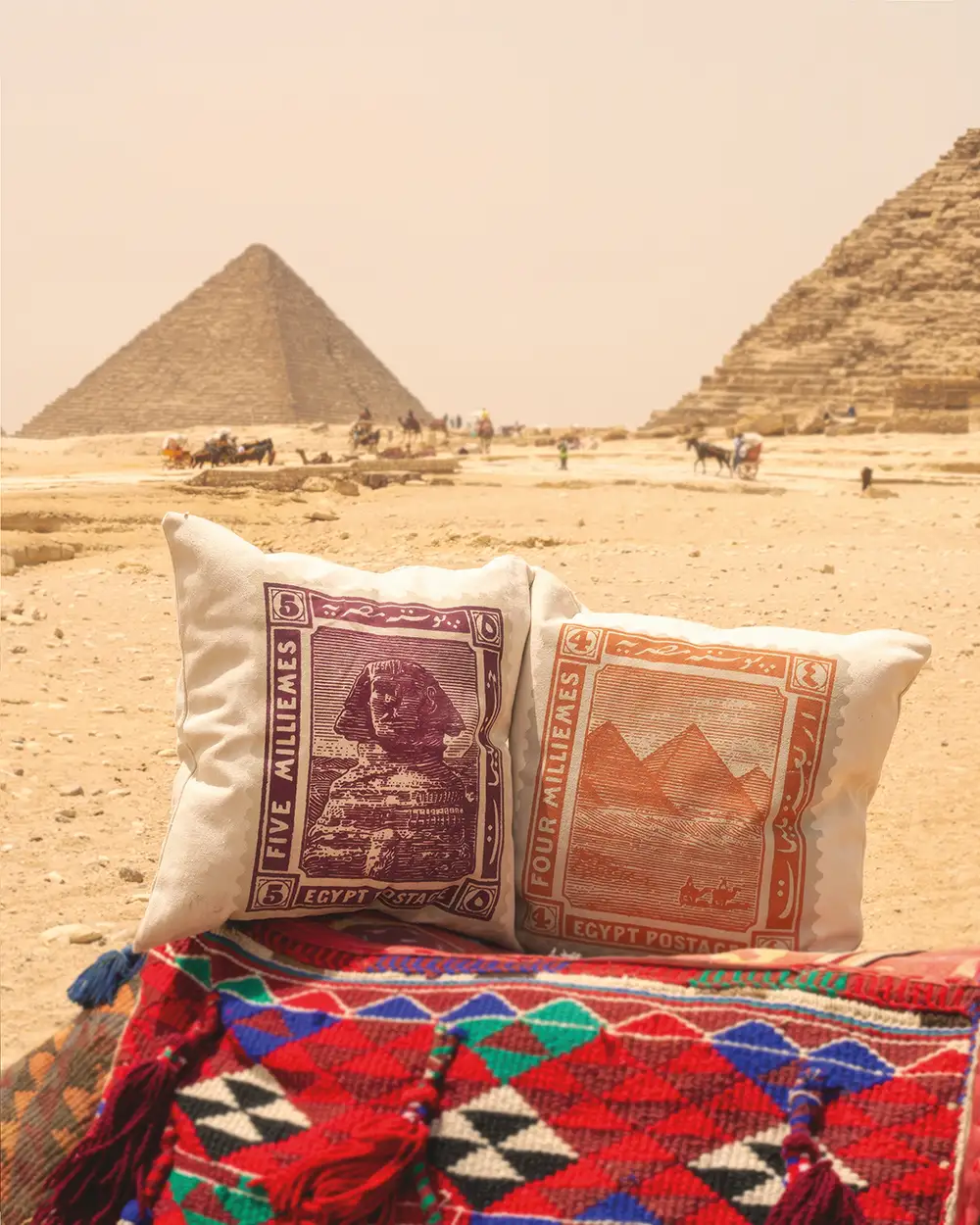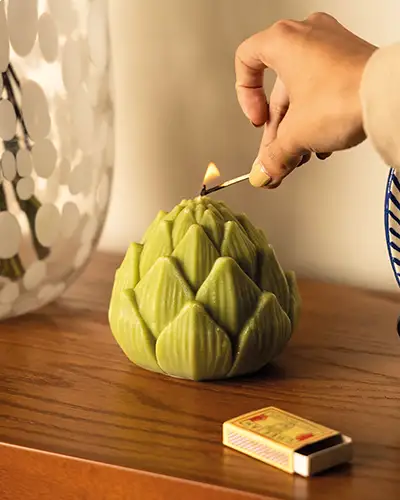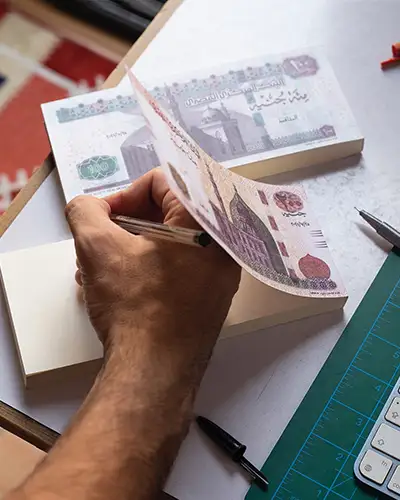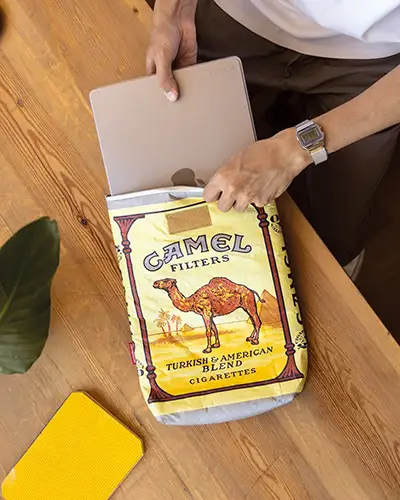Branding the city
Cairopolitan’s souvenirs and collectables are rooted in Cairo’s contemporary identity.
By Georgina York
Pencil cases that look like Egyptian baladi bread. Candles masquerading as artichokes. Fridge magnets shaped like cassette tapes. Such whimsical treasures line the shelves of Cairopolitan, a concept store and art gallery squeezed between two residential buildings in the Egyptian capital’s Garden City neighbourhood. Cairopolitan is a world of colour, humour and design that aims to “brand the city” with souvenirs and collectables rooted in Cairo’s contemporary identity.
Other candles are shaped like sweet potatoes, corncobs and prickly pears, inspired by the seasonal produce sold on hand carts in the city’s markets. Coasters look like old postage stamps and coins, while tiny carpet beaters and whisks are reimagined as keychains, playfully referencing everyday Cairo tools. On one wall hang colourful hand-tufted rugs shaped like street signs and zanouba flip flops. Another displays a poster collection gathered over five years for Cairopolitan’s annual Cairo Prints exhibition, with more than 2,000 designs by over 500 artists.
Cairopolitan began as an idea in 2006, the brainchild of illustrator, graphic designer, sculptor, collector and prop-maker Ahmed Hefnawy. At the time, he worked in advertising. “He tried to suggest cool merchandise for each client he worked with, but they usually preferred to stay on the safe side rather than take the crazy side,” says Cairopolitan’s creative director Nelly El Sharkawy, who is also an architect, photographer and trained dancer, as well as Hefnawy’s business and life partner.
In 2006, Hefnawy began designing and producing items that represented this city full of idiosyncrasies, rough-around-the-edges charm, and tongue-in-cheek humour. “He noticed a gap in the souvenir market in Egypt, with everything being low quality, made in China, and without original designs,” El Sharkawy says. “All we had were things connected to the pharaohs from thousands of years ago, with little that reflected modern Egypt.” By 2017, Hefnawy had a collection of 14 products and felt ready to launch.

Opening image: Cairopolitan storefront with owner Ahmed Hefnawy. Above: Sphinx Postage Cushion and Pyramids Postage Cushion.
Among the first products Hefnawy designed—still top-sellers today—are the Baladi Pouch and the Rivo PillO cushion. The former looks like Egyptian flatbread, familiar to anyone who has seen cyclists pedalling through Cairo’s chaotic traffic, wooden frames stacked with bread balancing on their heads. The latter is named for a brand of aspirin. “Our mums and grandmas used to take it for everything from headaches to back pain,” El Sharkawy says. “It was like a magic pill, so Hefnawy decided to create the Rivo PillO because when you’re in pain, you want something comfy.”
Everything at Cairopolitan is made in Egypt, with the majority of items made in and around Cairo. There are Light Weight candles, shaped like the old metal weights on market scales, able, the description states, to “tip the scales towards relaxation”. Wall Paper tissues come in a box shaped like a brick, and tiny knitted falafels hold coins, keys, or earphones.
“People around us said that no one but Egyptians would understand our products because of the inside jokes,” Hefnawy says. However, today, only around 1% of Cairopolitan’s sales are to Egyptian customers. The rest are international, with tourists and residents coming to the store in person, and others picking up items at the new Grand Egyptian Museum gift shop, or ordering online. Cairopolitan products are also stocked in the Sharjah Art Foundation and Jeddah Islamic Arts Biennale boutiques, and have been featured at New York Design Week.
“You’d be surprised how familiar tourists become with our culture in just three days in Cairo,” Hefnawy says. “They eat the baladi bread, they recognise things like stop signs in Arabic. We feature everyday products. Anyone who walks in the streets of Cairo will recognise three or four of our products instantly.”
The majority of the products are made or finished onsite in Garden City, and the shop’s back-of-house spaces conceal busy workshops. Pots and pans of candle wax crowd kitchen surfaces. Moulds of Cairo icons in miniature wait in a corridor. In another room, hand-tufted carpets shaped like traffic cones, cigarette butts and Egyptian banknotes are made.



The creatives behind Cairopolitan, Ahmed Hefnawy and Nelly El Sharkawy. Artichoke Candle. Blank Note money notebook.
“We hire artisans and bring them here,” El Sharkawy says. “Over the past two years we’ve been trying to hire as many full-time, in-house artisans as possible so we can do the whole production onsite.”
Each product can take up to a year to develop. The tiny meat-cleaver keychain that is one of the brand’s bestsellers requires more than 20 steps executed by 10 different artisans—the same ones who make the regular-sized originals. It’s the same with the mini broom, its brush made from rice straw collected and combined by one craftsman while another works on the wooden elements, and the mini chairs modelled on those found in cafés all over the country. The components are brought to Cairopolitan’s workshop for assembly, finishing and labelling. “On average, our products undergo between seven and 25 steps, whether produced in-house or by outsourced collaborators,” El Sharkawy says.
Most of the artisans that El Sharkawy and Hefnawy work with are advanced in years. One challenge is that they often don’t pass the craft down to their children. “They think it’s better for them to study in university instead of learning craft from their parents,” El Sharkawy says. “It’s a very risky labour environment because when an artisan dies, the craft dies with them.”
El Sharkawy and Hefnawy recently purchased a 1,000-square-metre warehouse that will allow them to scale up production and train new artisans. “Our current space is tiny so it really limits us, but our new warehouse is huge and will be divided into fully equipped spaces for each craft,” El Sharkawy says.
And they aren’t stopping with Cairo. They’ve just launched Gizapolitan, and Alexandriapolitan is on the way, each with different product lines in development. El Sharkawy shows one of Gizapolitan’s first products, a sculpture of a disembodied nose. “No one has seen the Sphinx’s nose, so we tried to imagine what it looked like,” she says. Another mini-Sphinx sculpture, sealed in an acrylic box filled with sand, is in development. When tilted, the sand shifts to conceal the Sphinx; move it again, and it’s revealed.
“Even if a product has a pharaonic or Ancient Egyptian background, we’re still looking at something unconventional,” El Shar-kawy says. “We’ve been living for far too long without having something that really represented us.”


The Camel Packet laptop sleeve. The Baladi Pouch, based on the ubiquitous pita bread, is a bestseller. All images courtesy of Cairopolitan.


